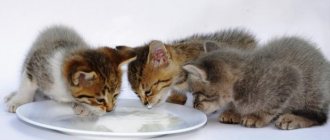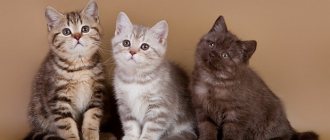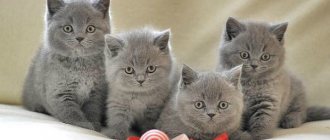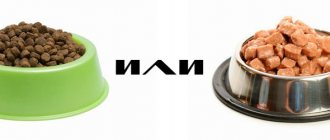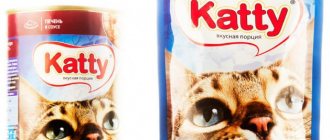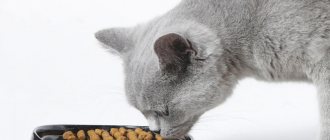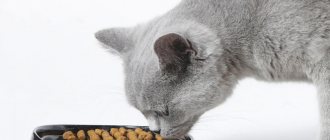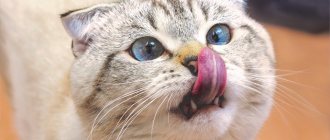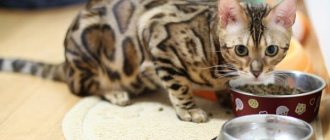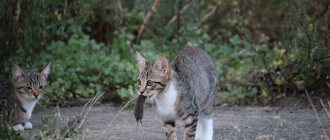Proper diet for cats
- Fact 1:
It is better not to give milk to a Bengal kitten. Only goat (low-fat) is allowed to avoid problems with digestion - Fact 2:
By the way, food for pregnant and lactating cats is also suitable for babies (almost identical composition to food for kittens). - Fact 3:
Bengals do not like fatty meats, so it is better to avoid beef and pork. - Fact 4:
You can cook a porridge mix from cereals, herbs and vegetables (but do not include potatoes, broccoli, onions and garlic)
A Bengal cat is a piece of wild nature in your home. Such beauty was achieved by crossing a simple domestic cat with a wild leopard cat. That is why the Bengal creature has an unusual spotted color and a completely ordinary “domestic” character. Of course, 20% of wild genes sometimes wake up in a pet, which is reflected in its disposition and food preferences.
The wild brothers of the Bengal cat hunt for their own diet: it is exclusively meat. Very rarely, leopard cats practice herbal medicine. Therefore, for the most part, the handsome Bengal will have to be fed with food of animal origin, and industrial food should only be of the highest quality.
Secrets of the Bengal diet
Despite the 100% meat diet of the leopard cat, you need to remember that Bengals are half domestic. And it is not necessary to feed them only meat. At least 20% of the diet should consist of other dishes: sea fish, cereals, vegetables, fermented milk cuisine. It is better not to give milk to a Bengal kitten. Only goat (low-fat) is allowed so that there are no problems with digestion.
You can cook a porridge mix from cereals, herbs and vegetables (but do not include potatoes, broccoli, onions and garlic). It is recommended to add 1 quail egg yolk to the porridge 1-2 times a week. If you have your own farm, or the eggs are purchased from trusted sources, raw yolk is allowed and mixed into the porridge. If the eggs were purchased in a store or from unverified sources, it is better not to take risks: you can infect the kitten with salmonellosis. Sometimes you can replace meat with offal (liver, heart). Bengals do not take well to fatty meats, so it is better to avoid beef and pork.
Make sure that your pet does not come across “surprises” in meat dishes: bones, beaks, skin, claws. The kitten may choke. Food must be at an acceptable temperature. Vitamins and minerals are required and must be discussed with your veterinarian. The kitten should have regular access to fresh drinking water.
What to feed a Bengal cat
From their wild counterparts, Bengal cats have inherited not only a playful character and an interesting color. The fact is that wild felines do not need a long esophagus. They feed exclusively on meat, so in the process of evolution they received a short intestine, which was inherited by this wonderful breed.
Because of this feature, owners often feed their pets something completely different from what they need. If you feed your four-legged friend for so long, he may develop quite serious digestive problems. This will have an extremely negative impact on his health and life expectancy.
Bengal cat eats dry food
It is important to understand what a cat can eat and what foods are best kept away from him. Let's figure it out.
Ready-made food or natural food
This is the first question that arises for the owners of any cat. Here you need to think about the fact that Bengal cats, and most other pets, get stomach problems when switching from food to natural food.
The main diet of the wild relatives of this breed is meat. A domestic cat needs a balanced diet, but it is best to use ready-made food. The finished products already contain all the substances a Bengal cat needs. With them, the animal will not have digestive problems, and he will be able to live a full, happy life.
Bengal begs for minced meat
But Bengal cats, who are fastidious in their diet, can and should be fed only with fairly expensive food that belongs to the premium class. Not everyone can afford to buy expensive, high-quality cat food, and cheap food from the supermarket can only harm the cat.
If possible, it is better to feed your Bengal ready-made, balanced koma. Let's look at which foods are best suited.
The best ready-made food for Bengal cats
Here we will try to provide food for Bengals that is approved by experts in the field of cat breeding or veterinarians.
Table 1. Best dry food for Bengal cats.
| Name | Description |
| Orijen Six Fish Cat | This is a holistic fish food that contains everything a cat needs for normal life. The food consists of 42% protein, which is taken from salmon, poultry and other fish, and 20% fat. These are excellent indicators for cat food. But the fat in this version comes from canola oil, which is a fairly cheap and low-quality source of fat. The food contains many substances, including medicinal plants. |
| WildCat Etosha | This is expensive German food. This food contains 46% protein and 23% fat. Most of the protein comes from chicken and chicken meal. In addition, the food contains no grains, and there are special prebiotics that ensure the absence of digestive problems even in fastidious Bengal cats. |
| Royal Canin Bengal Adult | This product can only be given to animals that are over one year old. In addition, it contains corn, which the cat could theoretically be allergic to. Therefore, you need to carefully monitor your cat’s reaction to this food. If he doesn’t like it, then it’s better not to risk it and buy another one. Contains important vitamins that a cat needs for normal functioning. This French food is also not very expensive, and its protein content is 40% and fat - 18%. |
Natural food for Bengal kittens
Cats of this breed can be fed regular food. It is important to choose the right food for your pet.
A cat's diet should consist of approximately 70% raw meat. To avoid infecting your cat with parasites, you need to keep the meat in the freezer for a long time - up to 4 days if it is a regular freezer.
Bengal cat eats meat
After removing from the freezer, the meat should be doused with boiling water and cut into medium-sized pieces. For young and healthy cats, there is no need to grind the meat. Bengal cats need stress on their teeth and jaws.
Your cat's diet can include:
- lung;
- kidneys;
- boneless fish meat;
- cottage cheese with a low fat content. Less than 5 percent is preferable;
Bengal cat near a bowl
- vegetables, both raw and cooked. Vegetables in a cat's diet should be about 15% of the total amount of food;
- When kittens lose teeth, they can be given bird necks. They need to be cleaned of all excess and cut;
- cereals, such as rice or buckwheat. Cereals account for 5% of the Bengali diet;
- eggs, quail eggs are perfect. In the wild, representatives of the cat family often destroy bird nests and feast on eggs.
Some cat breeds should not be given milk. Bengal cats are not like that. Most of them calmly drink cow's milk. But, although rare, an animal may be allergic to it. Therefore, you should give milk to your Bengal with caution, studying his reaction to the new drink.
Allergy is the sensitivity of an animal's immune system to certain allergens, some of which can even lead to the death of the four-legged animal. The reaction to allergens manifests itself in cats with certain symptoms. You can read more about allergies to food in cats in our separate article.
Ready-made food: tips and nuances
If you decide to please your Bengal pet with the highest quality industrial food, make sure that the label says “For kittens.” By the way, food for pregnant and lactating cats is also suitable for babies (almost identical composition to food for kittens). It’s impossible to say for sure which industrial food your baby will love. Cats, like people, have their own food preferences.
But wise intervention by the owner in the diet is mandatory. It is better not to mix different brands of food, just as you should not give ready-made food with “natural” food in the same bowl. Make it a rule: each type of food is in its own bowl.
Expert cat breeders recommend Royal Canin for any breed as a proven food. But besides this, there are several other excellent cat treats.
Dry food
- "Royal Canin Mother & Babycat" . Suitable for both pregnant cats and babies up to 4 months (although many owners successfully give this food to kittens up to 7 months of age). Special proteins and prebiotics are perfectly absorbed, and vitamins and antioxidants support the Bengal baby’s immunity. Pieces of food are easy to soak, which helps to painlessly transfer the kitten from milk to solid food.
- "Royal Canin Kitten " Recommended for kittens from 4 months to one year. Special proteins and fiber from plantain seeds take care of the baby’s gastrointestinal tract, regulate the balance of intestinal microflora and relieve problems with stool. The food is rich in vitamins and is able to fully provide energy and protection to the kitten’s growing body.
- "Sanabelle Kitten " Suitable for pregnant cats and babies up to one year old. Amino acids of the highest quality and the correct proportion of nutrients have a beneficial effect on the entire cat’s body: strengthens bones and teeth, regulates the gastrointestinal tract, takes care of the kitten’s fur and skin, and most importantly, supports its strong immunity. Experts joke that this food is so tasty and safe that the owners themselves would gladly feast on it if not for moral prejudices.
Wet food (canned)
- "Pro Plan Nutris Vour Junior" . Everything a small cat's body needs is contained in a serving of this healthy food. Omega-3 fatty acids improve vision and brain function. Calcium and phosphorus build the baby's skeleton and muscles. The balanced formula of the canned food is suitable for the first feeding of a kitten, as well as for a nursing mother cat.
- "Iams Kitten & Junior Chicken in Sause" . Canned chicken meat is great for kittens from 3 weeks to one year. The appetizing pieces in the sauce contain the required amount of all valuable substances: proteins, calcium, phosphorus, fiber, fats and vitamins. Their correct balance helps the kitten to fully develop and have a healthy, strong immune system. Canned kibble can be mixed with any other food to make your pet’s diet as tasty and healthy as possible.
Nutrition for an adult Bengali
The best way to feed a cat, dry food or natural food, depends on each individual owner. Ready-made food is considered balanced and contains the entire range of nutrients a pet needs. This diet has many advantages, but there are also disadvantages.
The health of a cat depends on what food it is fed, since some dry or wet food contains components that are undesirable for a Bengal to consume. These are unnatural flavors and flavoring additives on which the cat becomes dependent, soy pomace, and other low-quality components. Every cheap cat food has these qualities.
More expensive foods are made from a variety of high-quality products; they include vitamins and nutritional components. These products have a higher cost. There are 4 main classes of feed, which are qualitatively different from each other. To figure out which food is better, let’s rank the most popular companies producing industrial diets:
- economy class – “Meow”, “Kitekat”, “Whiskas”;
- premium class for cats - “Royal Canin Bengal Adult”, “Mother Babycat Royal Canin”, “Hills”, “Bozita”;
- super-premium class - “1st Choice”, “Arden Grange”, “Cimiao”, “Chicopee adult cat”;
- holistic – “Acana”, “Orijen”, “Chicken Soup”.
The best product for Bengal cats will be of the holistic class - these foods are completely suitable for animals of a particular breed. You can use more common feeds that cost less, but the quality of such products will be appropriate. How to feed your pet a dry product is described on the packaging. There you can also find information on how to calculate the daily volume for a specific animal, taking into account its weight and age.
You can feed your Bengal cat natural food just as effectively and completely. The adult diet of an animal is based on the proportion: one part of food of animal origin to one part of plant origin. This is boiled meat, for example, beef or chicken, boiled fish, liver, hearts, kidneys, lungs, stomachs, raw and boiled vegetables, for example, carrots or beets, cereals (wheat, oatmeal).
A spayed cat or neutered Bengal cat should be fed low-calorie premium, super-premium or holistic food. It is imperative to ensure constant access to fresh water. As for natural foods, it is better to stick to low-fat and protein foods, for example, poultry and poultry-based cereals.
Whatever you feed your Bengal cat, you need to give the animal additional vitamins. Bengals need specialized complexes with a high content of calcium and magnesium. The main indicator that food (natural or industrial) is suitable for an animal is its activity and well-being.
Forbidden food for Bengal kittens
Despite the fact that representatives of the Bengal breed are not prone to gluttony, they, like all cats, are curious and can beg their owner for delicacies that interest them. But the following foods are prohibited for kittens:
- cow's milk;
- fatty (and raw) meat: beef, turkey, duck, pork;
- bones of any kind;
- River fish;
- vitamin complexes for people;
- “human” dishes: roasts, soups, stews, salads;
- peas, beans;
- any sweets;
- flour;
- fruit seeds;
- fresh tomatoes and potatoes;
- garlic/onion.
Babies should be fed at the same time every day. If it is difficult for a kitten to chew dry food, it should be soaked in water or skim milk. Feed granules that are too large must be crushed. It is better not to mix dry food with natural food: in order to digest these different types of food, the cat's stomach produces different enzymes. Any failure can lead to indigestion and unpleasant consequences.
Vitamins and supplements
The presence of vitamin substances and additives is necessary if you give your animal natural food, because the finished food already contains vitamins for complete nutrition.
Natural sources of vitamins include fish oil, bone meal and brewer's yeast. Complex vitamin supplements are taken in courses, no more than 1-2 times a year, which helps strengthen the immune system, prevent joint problems and improve skin condition.
The choice can be made from the famous brands Canina, Gimpet, Sanal after consultation with a veterinarian.
Source
Age feeding scheme
At 3 weeks, the kitten must be introduced to the first complementary food consisting of pasty food (or special industrial food). Dry crushed food can be given at the age of 1.5 months. Up to 2 months, a kitten should eat 7-8 times a day. Below is the diagram:
- 1.5 – 2 months . The baby can only eat mother's milk, but it is recommended to supplement it. This can be industrial food or boiled meat, cut into small pieces. But babies eat pates/canned food better. The kitten should be fed 6 times a day.
- 3 months . The kitten is already able to chew dry food granules on its own. Dairy dishes should be reduced to 20% of the rest of the food. You can feed 5 times a day.
- 4 months . 40% of the diet should consist of cereals and vegetables, 60% - meat. At this age, the kitten can already begin to demonstrate its food preferences. An attentive owner will definitely notice them. The kitten is fed 4 times a day.
- 5 months . The diet includes fermented milk cuisine. The cat gradually gets accustomed to raw meat. Dry food no longer needs to be crushed or soaked. The kitten eats 3 times a day.
- 6-12 months . The baby is already ready for an “adult” diet. But he still really needs important vitamins and minerals as the body actively grows. It is better to choose products containing easily digestible proteins. The veterinarian will tell you what vitamins your pet needs.
If you have placed a piece of wild nature in the person of a Bengal kitten under your roof, be prepared to carefully take care of the menu of this unique creature. And his “thank you” will definitely be reflected in a shiny, healthy coat and a grateful purr.
Since birth
The kitten spends the first three months of its life in the nursery. A responsible breeder will not sell the pet too early; he will make sure that the Bengal receives adequate breastfeeding, social skills, and learns to use the litter box. The first vaccination and deworming are carried out here. The result will be good health, correct behavior, and an affectionate character. Bengals received a significant part of their genes from wild cats, but they are distinguished by their balance.
First month
Feeding a one-month-old kitten is entirely the responsibility of the mother cat. Breastfeeding provides him with all the necessary nutrients, as well as antibodies that form immunity. The breeder’s task is to monitor the health of the newborn, notice possible problems in time, ensure an appropriate level of hygiene, correct temperature conditions, and access to fresh air.
It happens that for some reason mother's milk is not available to the newborn. In this case, specialized suspensions are used for feeding. The number of feedings of a Bengal at the age of 1 month reaches six to eight times during the day. It must be remembered that if a kitten's body temperature is reduced, it will have problems swallowing. If your pet is hypothermic, you must first warm it up. Feeding cow or goat milk at this stage is unacceptable.
Second month
At this time, the first complementary foods are introduced. The digestive system is ready to digest solid food. The special composition for kittens begins to be introduced gradually:
- A small amount of feed is diluted with water to a liquid state.
- First, the kitten is simply given a taste of the resulting liquid.
- The body's reaction is monitored to identify allergic reactions or other digestive problems.
- Gradually the amount of feed is increased.
- The mixture is made thicker each time.
Gradually, dry food displaces water, and the older kitten learns to consume dry food. This strengthens his teeth and gums. It is a little easier to introduce complementary foods using pates. Some breeders prefer to immediately accustom kittens to natural nutrition.
Use finely chopped boiled meat. It is mixed with porridge (oatmeal, semolina, rice). The food should have the consistency of liquid sour cream. Later, the diet is supplemented with fermented milk products. At 2 months it is too early to completely switch a kitten to solid food; the share of mother's milk should be at least half of the total diet. The number of feedings is six times a day.
Third month
This is a period of active transition from mother's milk to solid food. By the fourth month, the process should be completed so that the pet, who will soon go to a new home, can feed on his own. The food is gradually made harder, the pieces of natural products become larger, but their size should be less than five millimeters. Dry food is no longer diluted by the end of the month. There is no need to do anything with pates; they are gradually replacing dairy nutrition. The number of feedings at 3 months is five times a day.
Description of the breed
The birthplace of Bengal cats is America. This species appeared in 1963 by crossing a leopard with a cat. At the same time, the oldest breed is the Egyptian Mau. She is considered to be the ancestor of all modern cats. The greatness, stature, plasticity, soft and smooth movements of the animal indicate that, perhaps, once upon a time all furry creatures were not pets at all. With their skills and habits, they could easily survive in the wild. The owners of Bengal cats claim that they have a serious and harmful disposition. Representatives of the breed love affection and attention from humans.
These cats are medium in size. They have a muscular body. True, in some areas of Asia there are wild Bengal cats, which reach a length of 80 cm. Scientists explain this by their habitat. The Bengal cat's tail is larger in diameter than that of a normal cat, but not long. Their paws are round. Cats of this breed have a long neck and a wide muzzle. The ears are medium in size and slightly tilted forward. The eyes are large and oval in shape. As for their color, Bengal cats have a variety of colors, except for blue. As for the coat color, it can be anything, but it always has clearly visible black or brown spots. The most prized are Bengals with leopard-print rosettes, which are a distinctive feature of this breed.
A few words about care
Most new owners are constantly worried about what to feed their Bengal kitten. The peculiarities of caring for a purebred pet also raise many questions, although in fact, Bengals do not cause almost any trouble in caring for them.
The kids are playful, quickly trainable and understand all the commands of their owners. If you teach them to follow certain rules from an early age, you will get an obedient adult cat with a balanced character.
Bengals love cleanliness, so their litter box should always be thoroughly cleaned. It is best to choose wood litter, since cats of this breed love to bury their excrement and cannot stand foreign odors.
From their wild ancestors they inherited a love of water and walks, so be prepared to purchase a harness and give your pet good exercise at least once a week. Kittens love to splash and splash water, they even drink it after carefully pushing away the non-existent dirt with their paws. In this regard, children should change the drinking water in the bowl at least twice a day.
Mini leopards are great at grinding their claws off on their own, but their ears and eyes need to be kept clean. It is enough to wipe them daily with a soft cloth.
As you can see, cats of this breed do not cause much trouble, but I would like to talk in more detail about their feeding. What to feed a Bengal kitten? The question is not an idle one, because the pet’s mood and health depend on the diet. Let's look at this topic.
When, how, how much to feed
A purchased Bengal cat baby first eats 5-6 times, after four months of life - 4 times, at six months - 3 times, and from 8-9 months, like adult cats, is invited to eat 2 times a day. The feeding rules are simple:
— dry food is poured strictly in quantities corresponding to the recommendations on the packaging: the animal must quickly, without leaving a trace, eat the entire portion;
— canned food, like natural food, is served slightly warm or at room temperature;
- raw meat and offal are first deep-frozen for five days, and then, after defrosting and pouring boiling water over them (preferably, but not necessarily), the pieces are given to the cat.
Whatever type of feeding is chosen, including mixed, it is unacceptable to leave any food in the bowl except “drying”. An animal can eat spoiled food - then eating disorders cannot be avoided.
When creating a diet, it is necessary to take into account the predisposition of Bengal cats to gain excess weight. During a long room stay, energy costs are low, therefore, calorie consumption may exceed their consumption. We are not talking about extra pounds - just 300-500 grams above the norm already have a negative impact on your pet’s health.
Basic nutritional features
In the wild, Bengal cats feed mainly on rodents and marsupials. These “products” can be replaced at home with different types of meat. For this breed, it is important that at least 70% of the total portion is meat.
The raw product is more beneficial for the animal. Since the likelihood of becoming infected with parasites from eating raw meat every day is very high, it is important to first freeze the meat in the freezer for at least 5 days.
Food for animals should be as fresh as possible. If the portion for your pet turns out to be too large and not finished, it should be thrown away and not left “for later.” All dishes should be neither hot nor cold. It is necessary that the food is at room temperature. Before giving meat from the freezer to the cat, it is recommended to pour boiling water over it and cut into small pieces.
The pet must know its place for feeding, as well as meal times. It is not allowed to give any snacks in response to an animal's begging.
Bengal cats can eat both natural products and ready-made premium commercial diets. It is not recommended to combine dry food with canned food or raw meat.
Character
The intelligence of Bengal cats is a mixture of incredible intelligence and instincts. The animals have a pronounced intelligence, cunning and cunning, which were probably passed on to them from their predatory ancestors. Bengal cats have well-developed front legs. They use them not only for walking or playing, like regular cats. Bengals try to pick up an object in their paws and even move it from one place to another.
They are incredibly playful and curious. They always try to get into places where they don’t need to. They can stare at a running washing machine for a long time, as well as out the window, watching passers-by. But for all their curiosity, Bengal cats are also smart. Therefore, they can climb anywhere, but they will never stick their nose where they may be in danger. You should not leave Bengal cats alone at home for a long time. Because they are very active. Their playfulness does not fade even with age.

